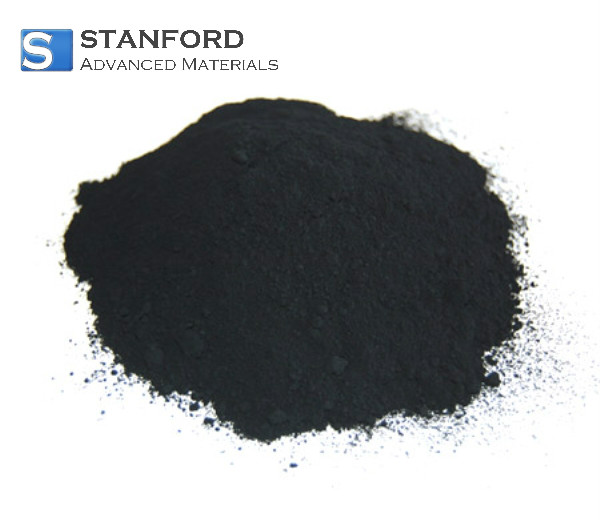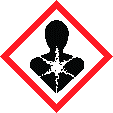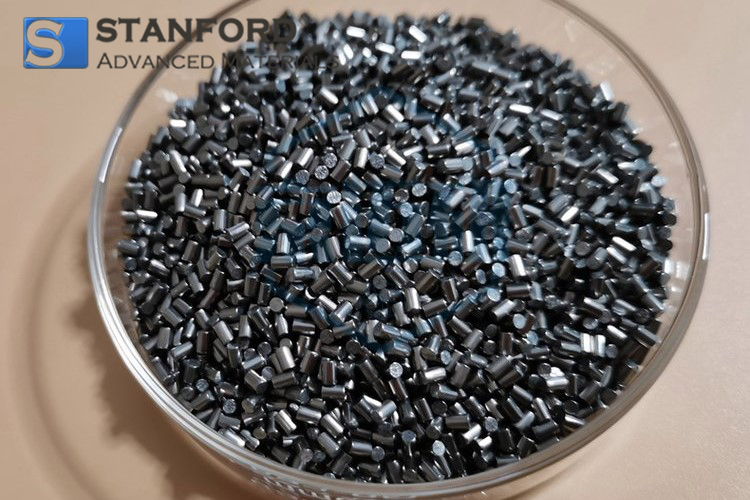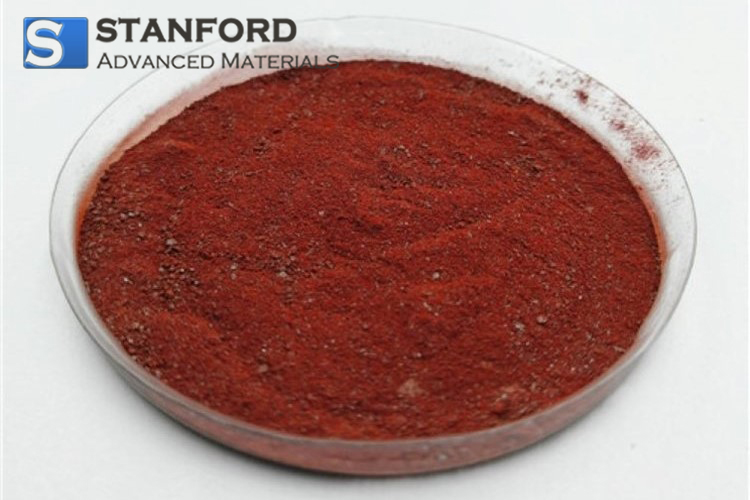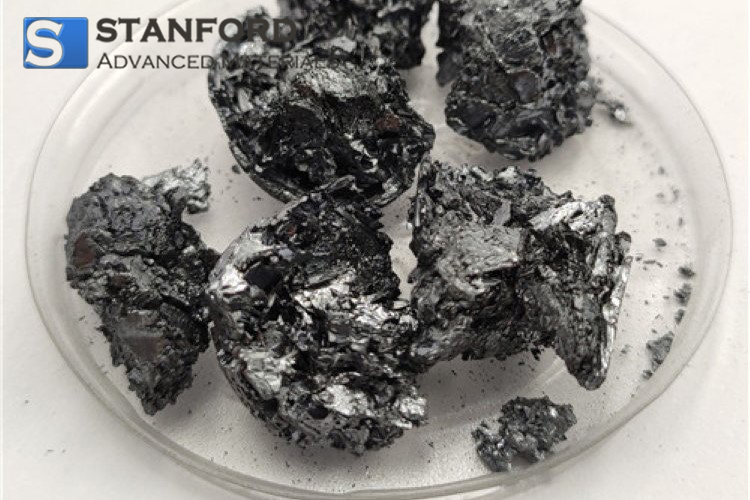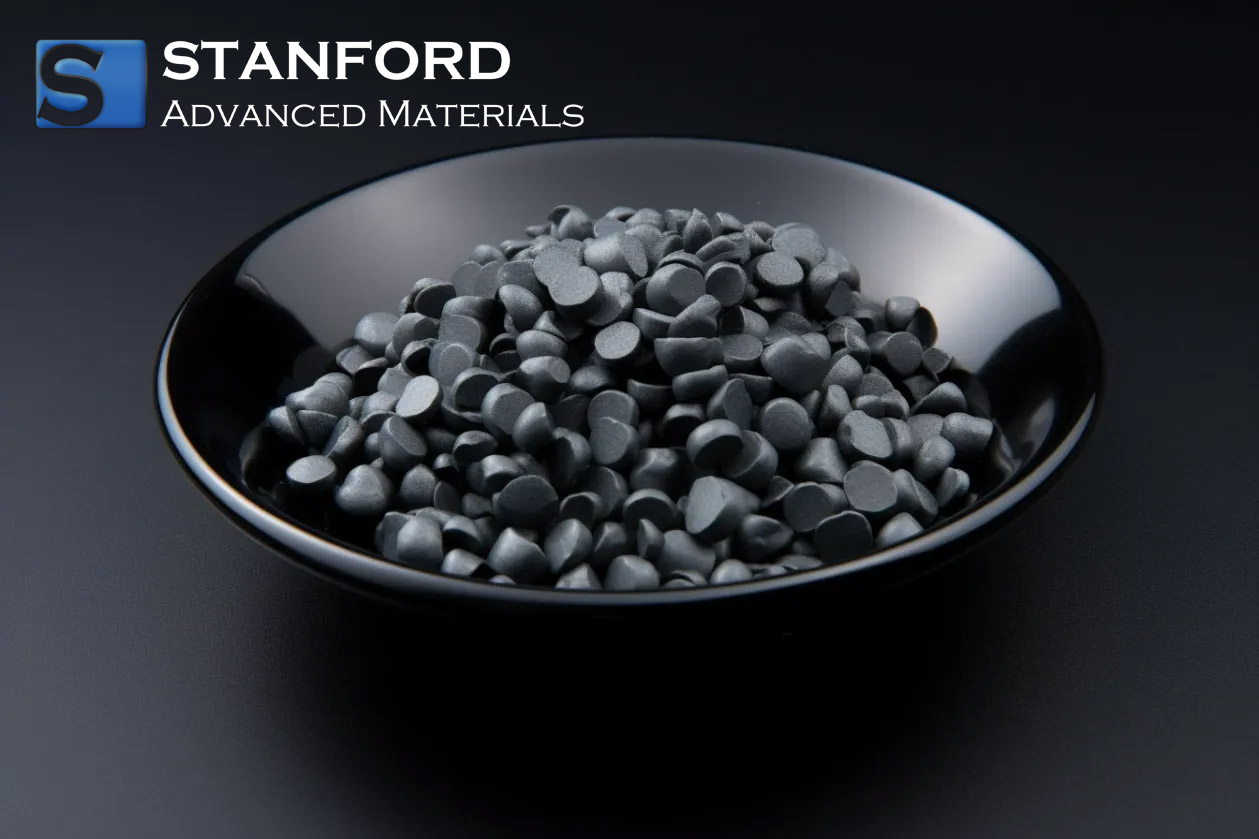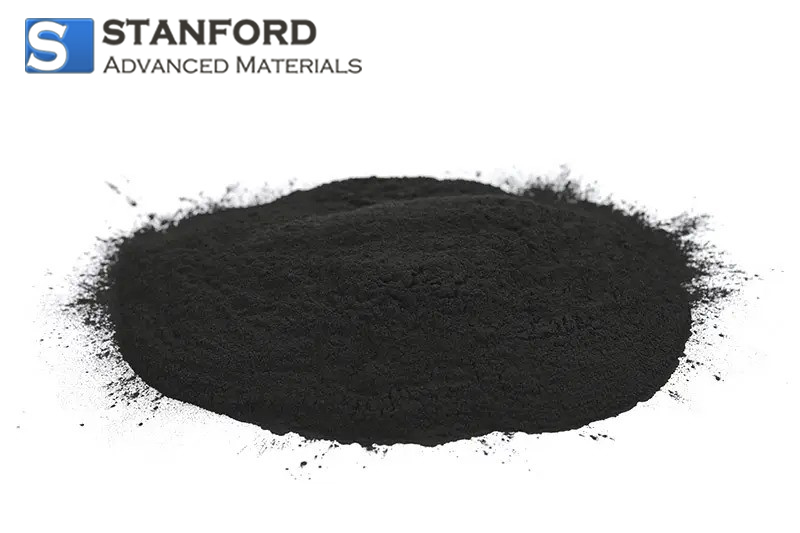SECTION 1. IDENTIFICATION
Product Name: Molybdenum(IV) Selenide
CAS #: 12058-18-3
Relevant identified uses of the substance: Scientific research and development
Supplier details:
Stanford Advanced Materials
E-mail: sales@samaterials.com
Tel: (949) 407-8904
Address: 23661 Birtcher Dr., Lake Forest, CA 92630 U.S.A.
SECTION 2. HAZARDS IDENTIFICATION
Classification of the substance or mixture
GHS Classification in accordance with 29 CFR 1910 (OSHA HCS)
Acute toxicity, Oral (Category 3), H301
Acute toxicity, Inhalation (Category 3), H331
Specific target organ toxicity - repeated exposure (Category 2), H373
Acute aquatic toxicity (Category 1), H400
Chronic aquatic toxicity (Category 1), H410
GHS Label elements, including precautionary statements
Pictogram
Signal word Danger
Hazard statement(s)
H301 + H331 Toxic if swallowed or if inhaled
H373 May cause damage to organs through prolonged or repeated exposure.
H410 Very toxic to aquatic life with long lasting effects.
Precautionary statement(s)
P260 Do not breathe dust/ fume/ gas/ mist/ vapours/ spray.P264 Wash skin thoroughly after handling.
P270 Do not eat, drink or smoke when using this product.
P271 Use only outdoors or in a well-ventilated area.
P273 Avoid release to the environment.
P301 + P310 + P330 IF SWALLOWED: Immediately call a POISON CENTER or doctor/
physician. Rinse mouth.
P304 + P340 + P311 IF INHALED: Remove victim to fresh air and keep at rest in a position
comfortable for breathing. Call a POISON CENTER or doctor/ physician.
P314 Get medical advice/ attention if you feel unwell.
P391 Collect spillage.
P403 + P233 Store in a well-ventilated place. Keep container tightly closed.
P405 Store locked up.
P501 Dispose of contents/ container to an approved waste disposal plant.
Hazards not otherwise classified (HNOC) or not covered by GHS - none
SECTION 3. COMPOSITION/INFORMATION ON INGREDIENTS
Substances
Formula : MoSe2
CAS-No. : 12058-18-3
EC-No. : 235-027-9
Index-No. : 034-002-00-8
Hazardous components
Component: Molybdenum(IV) selenide
Classification: Acute Tox. 3; STOT RE 2; Aquatic Acute 1; Aquatic Chronic 1; H301 + H331, H373,
H410
Concentration: <= 100 %
SECTION 4. FIRST AID MEASURES
Description of first aid measures
General advice
Consult a physician. Show this safety data sheet to the doctor in attendance.Move out of dangerous
area.
If inhaled
If breathed in, move person into fresh air. If not breathing, give artificial respiration. Consult a
physician.
In case of skin contact
Wash off with soap and plenty of water. Take victim immediately to hospital. Consult a physician.
In case of eye contact
Flush eyes with water as a precaution.
If swallowed
Never give anything by mouth to an unconscious person. Rinse mouth with water. Consult a physician.
Most important symptoms and effects, both acute and delayed
The most important known symptoms and effects are described in the labelling (see section 2.2)
and/or in section 11
Indication of any immediate medical attention and special treatment needed
No data available
SECTION 5. FIREFIGHTING MEASURES
Extinguishing media
Suitable extinguishing media
Use water spray, alcohol-resistant foam, dry chemical or carbon dioxide.
Special hazards arising from the substance or mixture
Selenium/selenium oxides, Molybdenum oxides
Advice for firefighters
Wear self-contained breathing apparatus for firefighting if necessary.
Further information
No data available
SECTION 6. ACCIDENTAL RELEASE MEASURES
Personal precautions, protective equipment and emergency procedures
Wear respiratory protection. Avoid dust formation. Avoid breathing vapours, mist or gas. Ensure
adequate ventilation.
Evacuate personnel to safe areas. Avoid breathing dust.
For personal protection see section 8.
Environmental precautions
Prevent further leakage or spillage if safe to do so. Do not let product enter drains. Discharge into the
environment
must be avoided.
Methods and materials for containment and cleaning up
Pick up and arrange disposal without creating dust. Sweep up and shovel. Keep in suitable, closed
containers for
disposal.
Reference to other sections
For disposal see section 13.
SECTION 7. HANDLING AND STORAGE
Precautions for safe handling
Avoid contact with skin and eyes. Avoid formation of dust and aerosols.Further processing of solid
materials may result
in the formation of combustible dusts. The potential for combustible dust formation should be taken
into consideration
before additional processing occurs.
Provide appropriate exhaust ventilation at places where dust is formed.
For precautions see section 2.2.
Conditions for safe storage, including any incompatibilities
Keep container tightly closed in a dry and well-ventilated place.
Moisture sensitive.
Storage class (TRGS 510): Non-combustible, acute toxic Cat.3 / toxic hazardous materials or
hazardous materials
causing chronic effects
Specific end use(s)
Apart from the uses mentioned in section 1.2 no other specific uses are stipulated
SECTION 8. EXPOSURE CONTROLS/PERSONAL PROTECTION
Additional information about design of technical systems:
Properly operating chemical fume hood designed for hazardous chemicals and having an average
face velocity of at least 100 feet per minute.
Control parameters
Components with limit values that require monitoring at the workplace:
Selenium and selenium compounds (as Se)
mg/m3
ACGIH TLV 0.2
Austria MAK 0.1
Belgium TWA 0.2
Denmark TWA 0.1
Finland TWA 0.1; 0.3-STEL
Germany MAK 0.1
Hungary 0.1-STEL
Ireland TLV 0.1
Japan OEL 0.1
Korea TLV 0.2
Netherlands MAC-TGG 0.1
Poland TWA 0.1; 0.3-STEL
Sweden NGV 0.1
Switzerland MAK-W 0.1
United Kingdom TWA 0.1
USA PEL 0.2
Selenium and selenium compounds (as Se)
mg/m3
ACGIH TLV 0.2
Austria MAK 0.1
Belgium TWA 0.2
Denmark TWA 0.1
Finland TWA 0.1; 0.3-STEL
Germany MAK 0.1
Hungary 0.1-STEL
Japan OEL 0.1
Korea TLV 0.2
Netherlands MAC-TGG 0.2
Poland TWA 0.1; 0.3-STEL
Sweden NGV 0.1
Switzerland MAK-W 0.1
United Kingdom TWA 0.1
USA PEL 0.2
Molybdenum and compounds (as Mo)
mg/m3
ACGIH TLV 10(Mo)
Austria MAK 15(Mo)
Denmark TWA 10(Mo)
Finland TWA 5(Mo)
Germany MAK 15(Mo)
Korea TLV 10(Mo)
Poland TWA 4(Mo); 10(Mo)-STEL
Sweden NGV 10(Mo)(total dust); 5(Mo)(resp. dust)
Switzerland MAK-W 10(Mo)
United Kingdom TWA 10(Mo); 20(Mo)-STEL
OSHA PEL 15(Mo)(total dust)Additional information: No data
Exposure controls
Appropriate engineering controls
Avoid contact with skin, eyes and clothing. Wash hands before breaks and immediately after handling
the product.
Personal protective equipment
Eye/face protection
Face shield and safety glasses Use equipment for eye protection tested and approved under
appropriate
government standards such as NIOSH (US) or EN 166(EU).
Skin protection
Handle with gloves. Gloves must be inspected prior to use. Use proper glove removal technique
(without
touching glove's outer surface) to avoid skin contact with this product. Dispose of contaminated gloves
after
use in accordance with applicable laws and good laboratory practices. Wash and dry hands.
Body Protection
Complete suit protecting against chemicals, The type of protective equipment must be selected
according to
the concentration and amount of the dangerous substance at the specific workplace.
Respiratory protection
Where risk assessment shows air-purifying respirators are appropriate use a full-face particle
respirator type
N99 (US) or type P2 (EN 143) respirator cartridges as a backup to engineering controls. If the
respirator is the
sole means of protection, use a full-face supplied air respirator. Use respirators and components
tested and
approved under appropriate government standards such as NIOSH (US) or CEN (EU).
Control of environmental exposure
Prevent further leakage or spillage if safe to do so. Do not let product enter drains. Discharge into the
environment must be avoided.
SECTION 9. PHYSICAL AND CHEMICAL PROPERTIES
Information on basic physical and chemical properties
General Information
Appearance:
Form: Powder
Color: Dark grey
Odor: Odorless
Odor threshold: Not determined.
pH-value: Not applicable.
Melting point/Melting range: 1200 °C (2192 °F)
Boiling point/Boiling range: Not determined
Sublimation temperature / start: Not determined
Flash point: Not applicable
Flammability (solid, gaseous): Not determined.
Ignition temperature: Not determined
Decomposition temperature: Not determined
Auto igniting: Not determined.
Danger of explosion: Product does not present an explosion hazard.
Explosion limits:
Lower: Not determinedUpper: Not determined
Vapor pressure: Not applicable.
Density at 20 °C (68 °F): 6 g/cm³ (50.07 lbs/gal)
Relative density Not determined.
Vapor density Not applicable.
Evaporation rate Not applicable.
Solubility in / Miscibility with Water: Insoluble
Partition coefficient (n-octanol/water): Not determined.
Viscosity:
dynamic: Not applicable.
kinematic: Not applicable.
Other information No further relevant information available.
SECTION 10. STABILITY AND REACTIVITY
Reactivity
No data available
Chemical stability
Stable under recommended storage conditions.
Possibility of hazardous reactions
No data available
Conditions to avoid
No data available
Incompatible materials
Hydrogen peroxideStrong oxidizing agents
Hazardous decomposition products
Other decomposition products - No data available
In the event of fire: see section 5
SECTION 11. TOXICOLOGICAL INFORMATION
Information on toxicological effects
Acute toxicity
No data available
Inhalation: No data available
Dermal: No data available
No data available
Skin corrosion/irritation
No data available
Serious eye damage/eye irritation
No data available
Respiratory or skin sensitisation
No data available
Germ cell mutagenicity
No data available
Carcinogenicity
IARC: 3 - Group 3: Not classifiable as to its carcinogenicity to humans (Molybdenum(IV) selenide, -
325 mesh)
ACGIH: No component of this product present at levels greater than or equal to 0.1% is identified as a
carcinogen or potential carcinogen by ACGIH.
NTP: No component of this product present at levels greater than or equal to 0.1% is identified as aknown or anticipated carcinogen by NTP.
OSHA: No component of this product present at levels greater than or equal to 0.1% is identified as a
Reproductive toxicity
No data available
No data available
Specific target organ toxicity - single exposure
No data available
Specific target organ toxicity - repeated exposure
No data available
Aspiration hazard
No data available
Additional Information
RTECS: Not available
To the best of our knowledge, the chemical, physical, and toxicological properties have not been
thoroughly
investigated.
SECTION 12. ECOLOGICAL INFORMATION
Toxicity
Aquatic toxicity: No further relevant information available.
Persistence and degradability No further relevant information available.
Bioaccumulative potential No further relevant information available.
Mobility in soil No further relevant information available.
Ecotoxical effects:
Remark: Very toxic for aquatic organisms
Additional ecological information:
General notes:
Do not allow material to be released to the environment without proper governmental permits.
Do not allow product to reach ground water, water course or sewage system, even in small quantities.
Danger to drinking water if even extremely small quantities leak into the ground.
Also poisonous for fish and plankton in water bodies.
May cause long lasting harmful effects to aquatic life.
Avoid transfer into the environment.
Very toxic for aquatic organisms
Results of PBT and vPvB assessment
PBT: Not applicable.
vPvB: Not applicable.
Other adverse effects No further relevant information available.
SECTION 13. DISPOSAL CONSIDERATIONS
Waste treatment methods
Product
Offer surplus and non-recyclable solutions to a licensed disposal company. Contact a licensed
professional waste
disposal service to dispose of this material. Dissolve or mix the material with a combustible solvent
and burn in a
chemical incinerator equipped with an afterburner and scrubber.
Contaminated packaging
Dispose of as unused product.
SECTION 14. TRANSPORT INFORMATION
DOT (US)
UN number: 3288 Class: 6.1 Packing group: III
Proper shipping name: Toxic solid, inorganic, n.o.s.
Reportable Quantity (RQ):
Poison Inhalation Hazard: No
IMDG
UN number: 3288 Class: 6.1 Packing group: III EMS-No: F-A, S-A
Proper shipping name: TOXIC SOLID, INORGANIC, N.O.S. (Molybdenum(IV) selenide)
Aldrich - 778087 Page 7 of 8
Marine pollutant: yes
IATA
UN number: 3288 Class: 6.1 Packing group: III
Proper shipping name: Toxic solid, inorganic, n.o.s. (Molybdenum(IV) selenide)
SECTION 15. REGULATORY INFORMATION
SARA 302 Components
No chemicals in this material are subject to the reporting requirements of SARA Title III, Section 302.
SARA 313 Components
The following components are subject to reporting levels established by SARA Title III, Section 313:
Molybdenum(IV) selenide
CAS-No.
12058-18-3
Revision Date
2007-07-01
SARA 311/312 Hazards
Acute Health Hazard
Massachusetts Right To Know Components
No components are subject to the Massachusetts Right to Know Act.
Pennsylvania Right To Know Components
Molybdenum(IV) selenide
CAS-No.
12058-18-3
Revision Date
2007-07-01
New Jersey Right To Know Components
Molybdenum(IV) selenide
CAS-No.
12058-18-3
Revision Date
2007-07-01
California Prop. 65 Components
This product does nnot contain any chemicals known to State of California to cause cancer, birth
defects, or any other
reproductive harm.
SECTION 16. OTHER INFORMATION
Safety Data Sheet according to Regulation (EC) No. 1907/2006 (REACH). The above information is
believed to be correct but does not purport to be all inclusive and shall be used only as a guide. The
information in this document is based on the present state of our knowledge and is applicable to the
product with regard to appropriate safety precautions. It does not represent any guarantee of the
properties of the product.
